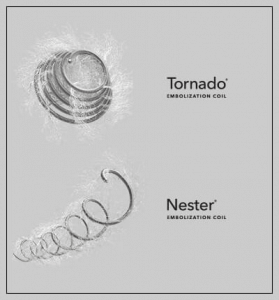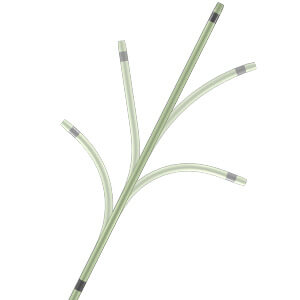
Blood may be the essence of life, but there are times when a physician needs to stop or redirect blood flow to treat a patient or even save their life. Using minimally invasive interventional techniques—an alternative to open surgery—embolic agents can be delivered through a microcatheter and implanted in tiny blood vessels to cut off blood supply to a particular area of the body. Coils and particles stop blood flow by creating an occlusion.
 The Cantata is used in small-vessel or superselective anatomy for diagnostic and interventional procedures, including peripheral and coronary use. Cook’s family of three Cantata Microcatheters are designed to deliver particles such as nonspherical PVA Foam Embolization Particles and microspheres, embolization coils, and other embolic agents, to very small vessels in the peripheral vasculature. The high-flow 0.027 inch inner diameter (ID) Cantata Microcatheter delivers relatively larger embolic agents to target anatomy while the 0.021 and 0.025 inch ID Cantata Microcatheters deliver 0.018 inch diameter microcoils and appropriate sizes of other embolic agents.
The Cantata is used in small-vessel or superselective anatomy for diagnostic and interventional procedures, including peripheral and coronary use. Cook’s family of three Cantata Microcatheters are designed to deliver particles such as nonspherical PVA Foam Embolization Particles and microspheres, embolization coils, and other embolic agents, to very small vessels in the peripheral vasculature. The high-flow 0.027 inch inner diameter (ID) Cantata Microcatheter delivers relatively larger embolic agents to target anatomy while the 0.021 and 0.025 inch ID Cantata Microcatheters deliver 0.018 inch diameter microcoils and appropriate sizes of other embolic agents.
Particles can be used where coils are too large, or where there are networks of small blood vessels feeding a tumor, a fibroid, or arteriovenous malformations. Because of their small size, particles can reach deeper into smaller arteries and wedge themselves there to stop the blood supply. Depending on the particle size needed, there is a Cantata Microcatheter to help deliver the agent. Each of the Cantata Microcatheters has a maximum particle size limit: 710 μm for the 2.5 FR superselective Cantata, 1000 μm for the 2.8 FR superselective Cantata, and 1,000 μm for the 2.9 FR high-flow Cantata.
 A unique feature of all Cantata Microcatheters is that their tips can be shaped by hand. This gives physicians several options for optimal access to difficult anatomy. You can shape the tip by hand to create curves that complement specific anatomy. It doesn’t require heat or steam. The hand-shapable feature of Cantata Microcatheters enables physicians to make anatomy-specific curves.
A unique feature of all Cantata Microcatheters is that their tips can be shaped by hand. This gives physicians several options for optimal access to difficult anatomy. You can shape the tip by hand to create curves that complement specific anatomy. It doesn’t require heat or steam. The hand-shapable feature of Cantata Microcatheters enables physicians to make anatomy-specific curves.
In addition to the unique hand-shapability of the braided tip, the microcatheter design also provides control and torquability. To enable optimal trackability, Cantata’s full-length stainless steel braid has five distinct transition zones that provide a seamless transition from hub to tip. The shaft also has a distal hydrophilic coating to ensure smooth introduction and manoeuvrability through arteries and veins. Ordering information is available here.
